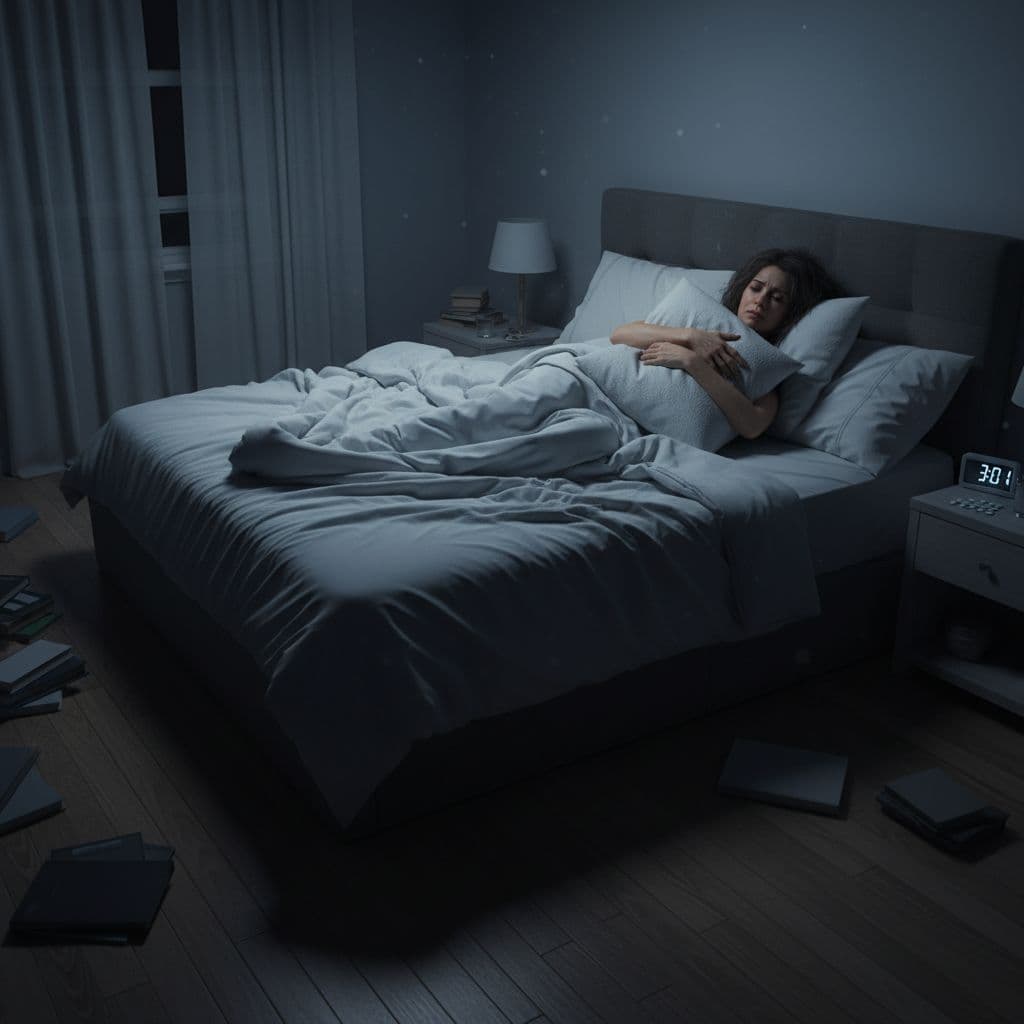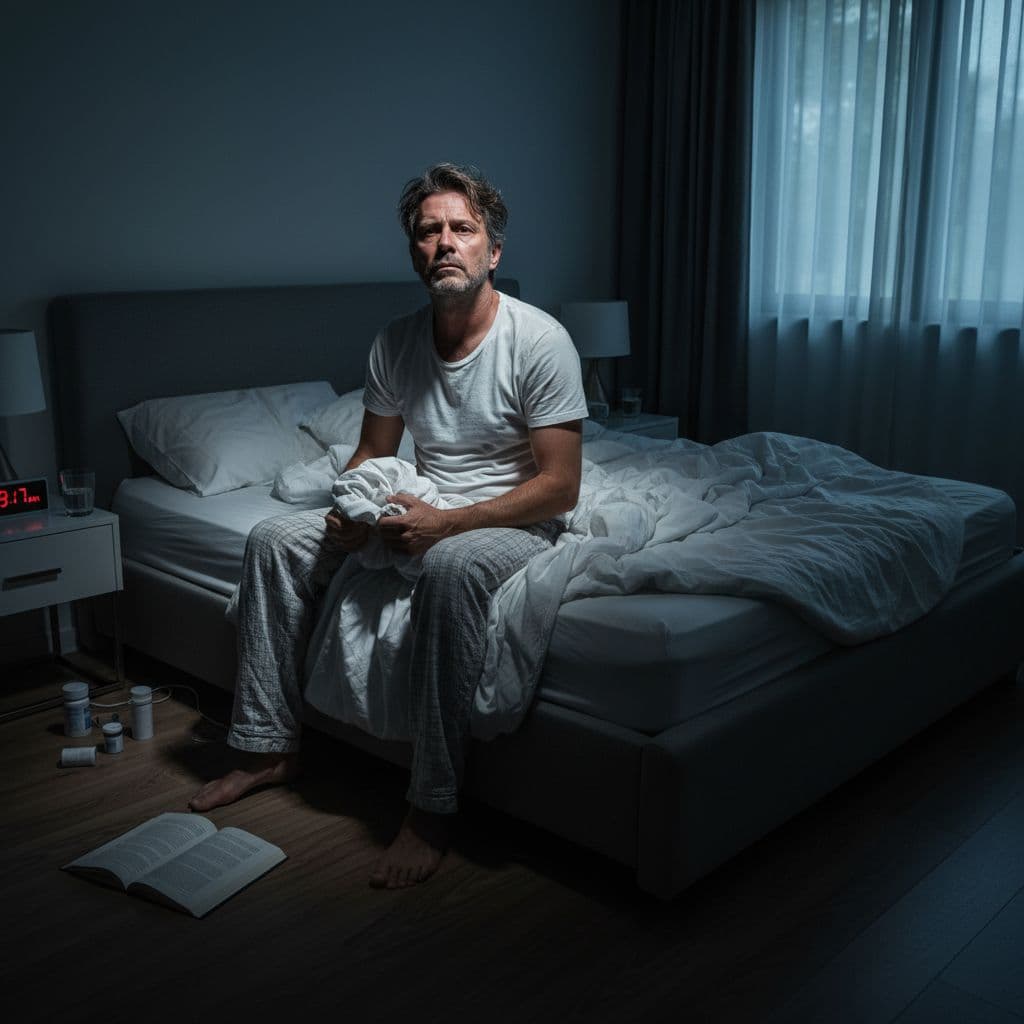Last night, I stared at the ceiling at 2 a.m., again. I watched the clock, did the math, and felt that wave of dread. If you know that tired ache behind your eyes, you’re not alone. Sleep Problems can leave you wired at bedtime, or wide awake before dawn.
Good sleep isn’t a luxury, it’s basic health. It shapes your mood, focus, appetite, and immune system. When it slips, everything feels harder, from work to relationships to workouts.
If you struggle to fall asleep, wake up often, or feel tired even after a full night, this guide is for you. We’ll cover:
- Types of Sleep Problems, like insomnia and sleep apnea
- Common causes, from stress to screens to schedule shifts
- Simple solutions you can try tonight, plus when to seek care
You deserve steady energy and a clear mind. Let’s make sleep feel doable again.
Understanding Common Sleep Problems and Sleep-Wake Disorders
Sleep Problems show up in different ways, but they share one theme, disrupted rest that spills into your day. You might lie awake for hours, snore and gasp at night, or feel sleepy at noon after a full eight hours. Knowing the pattern you face makes it easier to choose the right fix.
Two other conditions often tied to poor sleep deserve a quick callout:
- Narcolepsy: Sudden sleep attacks or overwhelming daytime sleepiness, sometimes with brief muscle weakness called cataplexy. This is a brain-based issue with sleep regulation, not a willpower problem.
- Restless legs syndrome (RLS): Uncomfortable leg sensations in the evening, a pull to move your legs, and sleep that breaks apart once you finally drift off.
Insomnia: Why You Can’t Fall Asleep
Insomnia is the classic battle with the pillow. You feel tired, get in bed, then your mind flips on. Common signs include:
- Racing thoughts at bedtime, replaying the day or planning tomorrow
- Short sleep duration, trouble falling or staying asleep at least three nights a week
- Daytime fatigue, foggy focus, irritability, and a heavy mood
Short-term insomnia is often tied to stress, illness, travel, or a life shift. It usually settles once the trigger passes. When it lasts three months or more, it becomes chronic. About one in three adults report insomnia symptoms, and around 10 percent live with chronic insomnia. That is millions of people lying awake, watching the clock, and feeling it the next day.
Insomnia also feeds into other Sleep Problems. Poor sleep raises anxiety, and anxiety raises arousal at night, a loop that keeps the brain on high alert. Breaking that loop takes the right plan and a bit of patience.
Sleep Apnea and Breathing Issues at Night
Sleep apnea interrupts breathing while you sleep. With obstructive sleep apnea (OSA), the airway narrows or collapses, often due to relaxed throat muscles. Signs look like:
- Loud snoring, pauses in breathing, or gasping that someone else notices
- Dry mouth, morning headaches, sore throat
- Restless sleep and waking up unrefreshed despite a long night
There is also central sleep apnea (CSA), where the brain does not send steady signals to the breathing muscles. CSA is less common and often ties to heart or neurological issues, high altitude exposure, or opioid use.
Both OSA and CSA cut sleep into fragments. Oxygen dips, the body surges with stress hormones, and the heart works harder. Untreated apnea is linked to high blood pressure, heart disease, stroke risk, insulin resistance, and stubborn daytime sleepiness. If your nights are noisy and your days feel heavy, apnea may be in the mix.
Circadian Rhythm Disorders in Sleep-Wake Cycles
Your circadian rhythm is your 24-hour body clock. When it drifts off schedule, sleep gets misaligned with your life, even if your total sleep time looks okay.
Common patterns include:
- Delayed sleep phase: You feel sleepy very late, often after midnight, and wake late if allowed. Night owls struggle with early classes, commutes, or kids’ schedules. You are not lazy, your clock runs later.
- Advanced sleep phase: You get sleepy in the early evening and wake up before dawn. Early birds often feel great at 5 a.m., then hit a wall after dinner.
- Shift work disorder: Rotating shifts or overnights force sleep at odd times. The clock never fully adapts, so you face short, broken sleep and strong sleepiness on the job.
- Jet lag: Rapid time zone changes create temporary misalignment. Eastbound trips often feel tougher because advancing the clock is harder than delaying it.
These mismatches create ongoing Sleep Problems, like trouble falling asleep on cue, early wake-ups, or feeling wide awake at the wrong time. The result is the same, foggy mornings, low mood, and a body that feels out of sync with the day in front of you.
Causes of Lack of Sleep Problems and Risk Factors
Sleep Problems rarely come from one thing. They usually build from small habits, hidden health issues, and a bedroom that fights your body clock. The good news is you can spot the patterns. When you fix the cause, sleep often follows.
Lifestyle Habits That Steal Your Sleep
Your daily choices write your night. A few tweaks can reduce arousal at bedtime and help your clock stay steady.
- Late-night eating: Heavy meals or spicy food near bedtime trigger reflux and body heat. Try a light snack if needed, and finish dinner 2 to 3 hours before bed.
- Caffeine after noon: Coffee, tea, soda, and pre-workout can linger for hours. Caffeine blocks adenosine, the brain signal for sleep. Cut off caffeine by early afternoon.
- Alcohol at night: A nightcap may help you doze, then fragments sleep later. It also worsens snoring. Stop alcohol 3 hours before bed and hydrate.
- Nicotine: It is a stimulant. Vaping or smoking near bedtime raises heart rate and alertness. Move nicotine earlier in the day and plan a taper.
- Blue light from phones: Screens reduce melatonin and keep your mind wired. Set a screen curfew 60 minutes before bed or use warm-light settings.
- Stress scrolling and late emails: The brain reads these as threats. Close the stress loop with a wind-down routine, like reading, stretching, or a worry list.
- Irregular sleep schedule: Constant bed and wake time shifts confuse your clock. Keep a consistent window, even on weekends, to protect circadian rhythm.
- Lack of exercise: Movement builds sleep pressure and improves deep sleep. Aim for 20 to 30 minutes most days. Finish hard workouts at least 3 hours before bed.
- Long or late naps: Naps after 3 p.m. drain sleep hunger. Keep naps short, around 20 to 30 minutes, and earlier in the day.
- Bedroom problems: Noise, light, heat, or an uncomfortable mattress make sleep light and jumpy. Cool the room, block light, add white noise, and fix bedding that hurts.
Why this matters: these habits push your sleep drive down, raise arousal, and shift your body clock later. Fixing them supports melatonin, increases deep sleep, and reduces night wake-ups. Start small. One change can reduce Sleep Problems this week.
Health Conditions Linked to Sleep Troubles
Medical issues often sit under stubborn Sleep Problems. Treating the root cause can change the night and the day.
- Thyroid disorders: Hyperthyroidism brings racing thoughts and a fast heart. Hypothyroidism can cause fatigue with restless sleep. Testing and treatment help stabilize nights.
- Heart disease and high blood pressure: Fluid shifts, chest symptoms, and medications can break sleep. Obstructive sleep apnea often coexists and strains the heart. Screen for apnea if snoring or gasping shows up.
- Obesity: Extra neck and belly weight raises apnea risk and reflux. Modest weight loss, even 5 to 10 percent, can improve breathing at night.
- Diabetes and blood sugar swings: Night hypoglycemia or high glucose disrupts sleep. Stable evening meals and medication timing help smooth the night.
- GERD, asthma, and allergies: Night cough, postnasal drip, and heartburn pull you from deep sleep. Elevate the head of the bed and treat airway inflammation.
- Chronic pain: Arthritis, migraines, back pain, and neuropathy fragment sleep, then poor sleep boosts pain sensitivity. A pain plan that includes nighttime relief can break the loop.
- Hormone shifts: Perimenopause, hot flashes, and pregnancy change temperature control and breathing. Cooling strategies and tailored care make a real difference.
- Medications: Stimulants, some antidepressants, decongestants, steroids, and beta blockers can disturb sleep or suppress melatonin. Ask your clinician about timing or alternatives.
- Mental health: Anxiety, depression, and PTSD raise nighttime arousal and deepen sleep deprivation effects, like low mood, poor focus, and fatigue. Untreated symptoms keep the cycle going.
Key takeaways:
- Untreated conditions fuel sleep fragmentation, then poor sleep worsens symptoms the next day.
- Addressing the root problem often restores sleep, not just masking it with melatonin or tea.
- Early care prevents a hard cycle of stress, pain, and insomnia from taking hold.
If any of these sound familiar, bring them up with your clinician. Your plan should target both the condition and the sleep pattern. That is how you turn Sleep Problems into steady rest.
Effective Ways to Fix Sleep Problems and Get Better Rest
You deserve a night that restores you, not a fight with the clock. Small, consistent changes can reset your body clock, calm a busy mind, and cut through stubborn Sleep Problems. Start with habits you control. If sleep stays rough, medical care can target the root cause and give you relief.
Building Good Sleep Hygiene Habits
Think of sleep like a routine your brain learns. The goal is a steady schedule, a calm wind-down, and a room that cues rest.
Start here:
- Set a consistent wake time seven days a week. This anchors your circadian rhythm and makes it easier to fall asleep at night.
- Create a 30 to 60 minute wind-down. Keep it quiet and repeatable. Try reading on paper, gentle stretching, a warm shower, or a short breath practice like 4-7-8.
- Keep bed for sleep and intimacy only. If you cannot sleep after 20 to 30 minutes, get up, do a calm activity in dim light, then return when sleepy.
- Build a cool, dark, quiet room. Aim for 60 to 67°F, use blackout curtains or an eye mask, and add white noise if needed.
- Limit alcohol at night. Stop three hours before bed. It may help you doze, but it fragments sleep and worsens snoring.
- Avoid caffeine after noon and skip nicotine at night. Stimulants hang around longer than you think.
- Skip late or long naps. If you need one, keep it to 20 minutes before 3 p.m.
- Finish dinner 2 to 3 hours before bed. Choose a light snack if hungry, like yogurt or a banana.
- Set a screen curfew. Power down phones and tablets 60 minutes before bed or use warm-light settings and night modes.
- Try natural soothers. Chamomile or lemon balm tea can be calming. Keep expectations realistic and avoid mixing with alcohol or sedatives.
Why this helps: steady wake times and a wind-down raise sleep pressure, reduce mental arousal, and support melatonin. A cool, dark room improves deep sleep and cuts night wake-ups. Less alcohol and caffeine reduce fragmented sleep. Together, these steps ease lack of sleep problems and give you predictable rest.
Example wind-down you can copy:
- 9:15 p.m., lights down, phone in another room
- 9:20 p.m., warm shower
- 9:35 p.m., stretch or foam roll for 5 minutes
- 9:40 p.m., journal a short worry list, then write tomorrow’s top three tasks
- 9:50 p.m., read fiction
- 10:15 p.m., lights out
If mornings feel brutal, shift your schedule by 15 minutes every few days until you land on a time that fits your life and still protects your sleep.
Medical Treatments for Persistent Sleep Issues
When strong habits are not enough, it is time for targeted care. The right treatment depends on the pattern you face.
- Cognitive Behavioral Therapy for Insomnia (CBT‑I)
- The gold standard for chronic insomnia. It blends sleep scheduling, stimulus control, and thought work that lowers night anxiety. Most people see better sleep in 4 to 8 sessions. Digital CBT‑I programs can help if you cannot find a local provider.
- Continuous Positive Airway Pressure (CPAP) for sleep apnea
- A small machine keeps your airway open with gentle air. Results can be fast, with fewer awakenings, lower blood pressure, and better morning energy. If CPAP feels hard, ask about mask refits, humidifiers, or pressure adjustments.
- Oral appliances for apnea and snoring
- A dentist-trained device moves the jaw slightly forward to open the airway. Helpful in mild to moderate obstructive sleep apnea, or when CPAP is not tolerated.
- Light therapy for circadian rhythm disorders
- Bright light in the morning can shift a late body clock earlier. Use a 10,000 lux light box for 20 to 30 minutes soon after waking, paired with dim evenings. For early birds who fade too soon, move bright light to late afternoon or early evening.
- Prescription sleep aids
- Options include non-benzodiazepine hypnotics, low-dose doxepin, orexin receptor antagonists, or short courses of benzodiazepines when needed. These work best as short-term supports alongside CBT‑I. Discuss risks like next-day drowsiness or dependence.
- Melatonin and timed dosing
- Low doses, usually 0.5 to 3 mg, can help with jet lag and delayed sleep phase. It is less helpful for chronic insomnia. Take it 3 to 6 hours before your target bedtime for clock shifting, not right at lights-out.
- Restless legs and movement disorders
- Iron testing comes first. If ferritin is low, iron therapy can help. Other medications are available when symptoms persist.
- Natural options with care
- Magnesium glycinate may relax tight muscles. Valerian has mixed evidence and can interact with meds. Keep your doctor in the loop to avoid side effects.
When to see a sleep specialist:
- Loud snoring, choking, or gasping at night
- Regular morning headaches or severe daytime sleepiness
- Insomnia that lasts more than 3 months despite good habits
- Shift work symptoms that make work unsafe
- Suspected narcolepsy, parasomnias, or frequent leg kicks
- Heart or lung disease with nighttime breathing trouble
A specialist can order a sleep study, tailor therapy, and coach you through the early bumps. You do not have to figure out stubborn Sleep Problems alone. With the right plan, better nights are within reach.
Conclusion
Sleep Problems get easier when you name the pattern, like insomnia, apnea, or a circadian shift, and when you address the habits and health issues that keep nights broken. Small steps work best, then medical care fills the gaps when needed.
Choose one change tonight, set a steady wake time, move screens out of the bedroom, or start a wind-down routine. Better sleep brings clearer focus, steadier mood, stronger workouts, and a healthier heart.
If this helped, subscribe for more simple wellness tips that you can use right away. Your next good morning starts now.

Có thể bạn quan tâm
TRỰC TIẾP XỔ SỐ MIỀN NAM – KÊNH THÔNG TIN CHUẨN XÁC, NHANH NHẤT VÀ ĐÁNG TIN CẬY NHẤT HIỆN NAY
Trong đời sống hiện đại, giữa hàng nghìn nguồn thông tin xuất [...]
Tap Into Your Musical Hitmaker: Dive Into Professional Hip-Hop Production with Break It Down
In the vibrant world of music production, where beats drop like thunder [...]
Trực Tiếp Xổ Số – Nguồn Cập Nhật Kết Quả Nhanh, Chuẩn, Đáng Tin Cậy Hàng Ngày
Trực tiếp xổ số – thói quen quen thuộc của hàng triệu [...]
Thuê xe nâng ở đâu uy tín, giá rẻ, chất lượng tốt nhất hiện nay?
Bạn có thể thuê xe nâng từ các công ty chuyên cho thuê thiết [...]
Làm chủ thị trường forex qua 5 bước ngắn gọn
Nắm bắt thị trường qua 5 bước đơn giản- Giao dịch là [...]
Sleep Problems: Causes, Symptoms, and Real Solutions
Last night, I stared at the ceiling at 2 a.m., again. I [...]